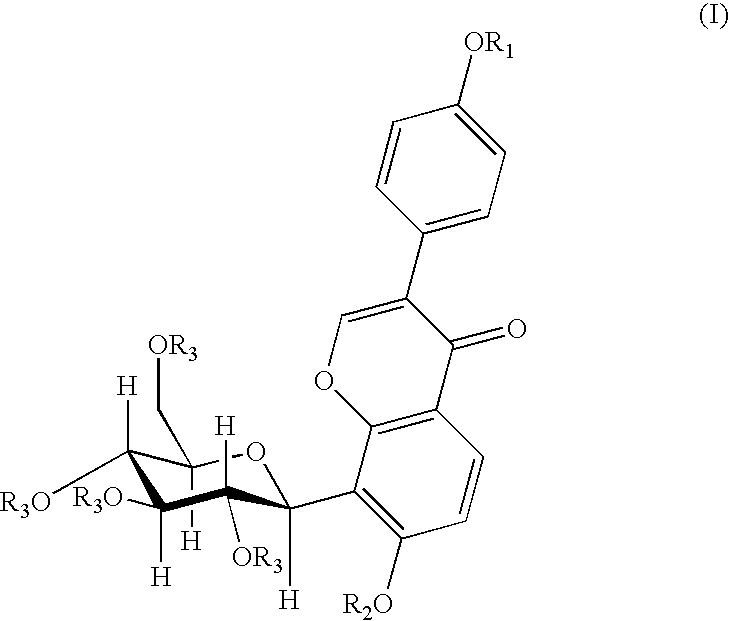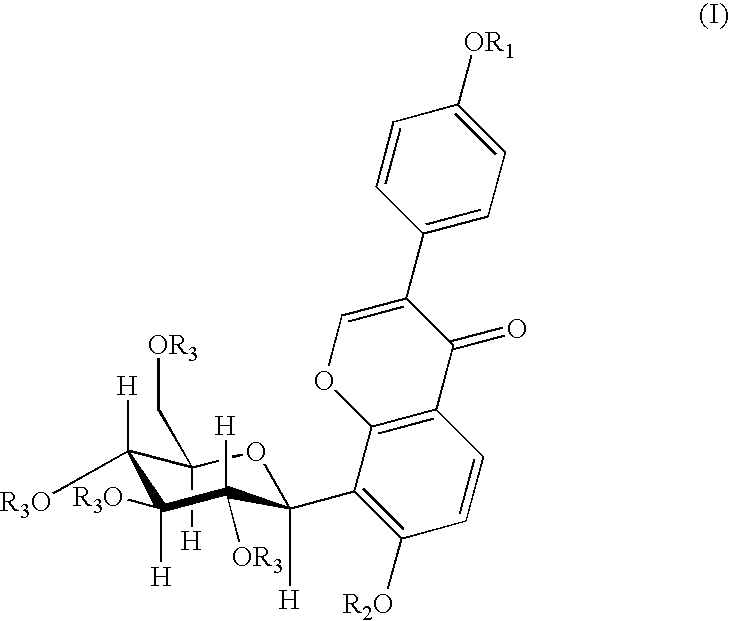C-glycosylisoflavones having alkylaminoalkoxyl substituent, preparation and use of the same
a technology of c-glycosylisoflavones and alkylaminoalkoxyl, which is applied in the field of c-glycosylisoflavones having alkylaminoalkoxyl substituents and pharmaceutically acceptable salts, can solve the problems of affecting the procedure of human body heat production and loss, puerarin has some adverse effects in clinical applications, and ineffective antibiotic treatmen
- Summary
- Abstract
- Description
- Claims
- Application Information
AI Technical Summary
Benefits of technology
Problems solved by technology
Method used
Image
Examples
example 1
4′-(3-bromopropoxy)-7-hydroxy-8-β-D-(1-deoxyglucosyl)isoflavone (PC3)
[0030]A 0.16 g (4 mmol) of sodium hydroxide was dissolved in 120 ml of anhydrous ethanol, and 0.8 g (1.92 mmol) of puerarin was added and dissolved completely by heating and refluxing. After slightly cooling, 0.20 ml (2 mmol) of 1,3-dibromopropane was added dropwisely. The reaction was continued for 5 hours under reflux. When the reaction was finished, the solvent was removed by distillation, and the resultant residue was separated by silica gel column chromatography (methylenechloride:methanol=8:1) to give 0.53 g of the title compound, yield 51.5%. mp: 196-197° C.
[0031]1H NMR (d6DMSO) δ(ppm): 8.39 (1H, s, C2—H), 7.95 (1H, d, J=8.7, C5—H), 7.52 (2H, d, J=6, C2′,5′—H), 7.01 (2H, d, J=6, C3′,6′—H), 6.99 (1H, d, J=10, C1″H), 4.00 (2H, t-OCH2—), 3.69 (2H, q, —CH2Br), 2.28 (2H, m, —CH2—).
example 2
4′-(4-bromobutoxy)-7-hydroxy-8-β-D-(1-deoxyglucosyl)isoflavone (PC4)
[0032]A 0.16 g (4 mmol) of sodium hydroxide was dissolved in 120 ml of anhydrous ethanol, and 0.8 g (1.92 mmol) of puerarin was added and dissolved completely by heating and refluxing. After slightly cooling, 0.25 ml (2 mmol) of 1,4-dibromobutane was added dropwisely. And the reaction was continued for 5 hours under reflux. When the reaction was finished, the solvent was removed by distillation, and the resultant residue was separated by silica gel column chromatography (methylenechloride:methanol=8:1) to give 0.53 g of the title compound in the form of a white solid, yield 47.2%. mp: 198° C.
[0033]FAB-MS, m / z (%): 552.1 (M++1.22).
[0034]1H-NMR (d6DMSO) δ(ppm): 8.36 (1H, s, C2—H), 7.96 (1H, d, J=9, C5—H), 7.52 (2H, d, J=9, C2′,5′—H), 7.01 (2H, d, J=9, C3′,6′—H), 6.99 (1H, d, J=9, C6—H), 4.86 (1H, d, J=10, C1″—H), 4.06 (3H, m, —OCH2-, C3″—H), 3.62 (2H, t, J=7, —CH2Br), 2.02 (2H, m, —CH2—), 1.99 (2H, m, —CH2—).
example 3
4′-(3-N-piperidylpropoxy)-7-hydroxy-8-β-D-(1-deoxyglucosyl)isoflavone
[0035]A 150 mg (0.27 mmol) of PC3 was dissolved in 15 ml of anhydrous ethanol, 0.13 ml (1 mmol) of piperidine was added under stirring, and then was heated and refluxed for 9 hours. When the reaction was finished, the solvent and the excessive amine were removed by vacuum distillation. The obtained product was separated by silica gel chromatography (methanol:triethylamine=200:1) and then was dissolved by an eluent (methylenechloride:methanol=6:1), and the silica gel was removed by filtration to give 80 mg of the title compound in the form of white solid, yield 52.9%. mp: 203-205° C.
[0036]FAB-MS, m / z (%): 542 (M+, 100).
[0037]1H-NMR (d6DMSO) δ(ppm): 8.31 (1H, s, C2—H), 7.91 (1H, d, J=9, C5—H), 7.51 (2H, d, J=9, C2′,6′—H), 6.97 (3H, q, J=9, C3′,5′—H, C6—H). 4.83 (1H, d, J=10, C1″—H), 4.01 (3H, mC3″—H, —OCH2—), 1.84 (2H, m, —CH2—), 1.51 (4H, HexahydropyridineC3,5—H), 1.47 (2H, HexahydropyridineC4—H).
PUM
| Property | Measurement | Unit |
|---|---|---|
| solubility | aaaaa | aaaaa |
| solubility | aaaaa | aaaaa |
| solubility | aaaaa | aaaaa |
Abstract
Description
Claims
Application Information
 Login to View More
Login to View More - R&D
- Intellectual Property
- Life Sciences
- Materials
- Tech Scout
- Unparalleled Data Quality
- Higher Quality Content
- 60% Fewer Hallucinations
Browse by: Latest US Patents, China's latest patents, Technical Efficacy Thesaurus, Application Domain, Technology Topic, Popular Technical Reports.
© 2025 PatSnap. All rights reserved.Legal|Privacy policy|Modern Slavery Act Transparency Statement|Sitemap|About US| Contact US: help@patsnap.com



